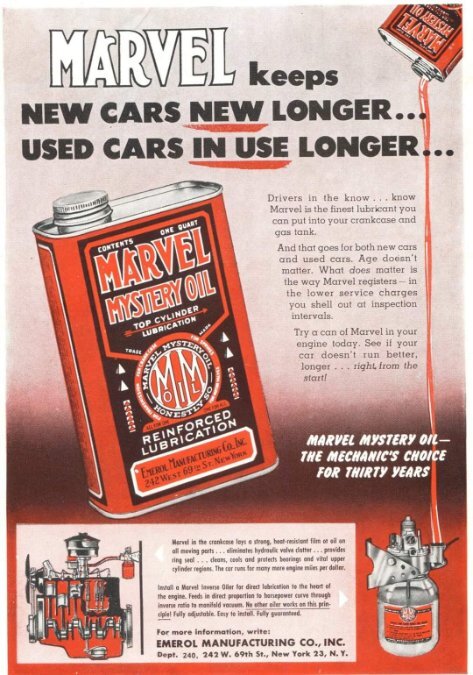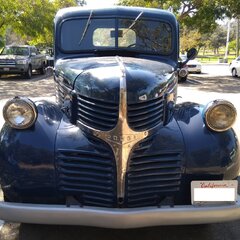Leaderboard
Popular Content
Showing content with the highest reputation on 09/29/2024 in all areas
-
Thanks Joe......I didn't see any notification to that effect...........I've had trouble getting onto various sites lately due to clicking on the wrong cookie reply........here in oz biscuits are what I like..........cookies not so much..............lol..............andyd1 point
-
1 point
-
With MMO, you can skip the non-ethanol gasoline...I did a price comparison of non-ethanol vs 87octane +MMO, and it's a dead heat, but ya get the fuel stabilizer benefit of MMO. Chrysler flatheads have hardened valve seats, so they run fine on modern gasoline...skip the lead additive and invest in MMO instead 🏆1 point
-
I blame it on the engineers .... A engine with zero compression I removed the head. I was totally amazed at the amount of pressure it took to move the valves back down .... literally almost nothing ... maybe 2-3 pounds pressure to push the valve back down? If there was just a slightly stiffer spring, they would pull the valve back down and this issue would not happen ..... IMHO I also realize my engine only produced 90 hp stock .... A stiffer spring would probably cost 5 hp and bring it to 85 hp ..... they did what they did. Great little engines, weak valve springs is just a curse they were born with.1 point
-
for years, I ran into the problem of gasoline and diesel engines big and small struggling to start after extended periods of disuse, and this would drain batteries and cook starters and elevate operators' blood pressures. Then one day I was reading the MMO label as it had changed packaging a little bit, and I was reminded of MMO as a fuel stabilizer. Since I started putting it in the tank regularly, engine startups are quick, batteries are lasting longer, and working on starters is not an almost annual chore. So nowadays, I purchase the 32oz bottle of MMO annually as the container is graduated but the caps wear out, and the gallon jugs as needed to refill that bottle...tell your friends!1 point
-
Hi all, some months ago I picked the brains of this Forum for my stock 1948 Dodge D25, and can now report on the results. The car now has Moog CC850 coils in the front and the rear leaves reset by a local guy here in Oz, and I couldn't be happier! The CC850's appear to give what I would regard as a 'standard ride height' from back in the day, and the transformation in the car's ride and particularly steering (due to less roll at the front) is far better than I'd hoped for (the car has standard 15 x 4.5" rims and 6.70 cross plies). For anyone running a similar 'stocker' I can definitely confirm that you will have a 'standard' look-no need to cut down the coil unless you want to lower-that does not sit too high, and drives beautifully. Thanks for the great advice from the Forum! Cheers, Nigel Bailey1 point
-
1 point
-
You may have to make your own, maybe a cardboard template to determine notch placement and size. Access to two of the three notches should work to turn it.1 point
-
Couple of things to note. Clean the housing well before you assemble it, aluminum swarf will be all in it. The screw that holds the timing plate to the bottom of the distributor is metric, M6 x 15 should be fine. You will also need an M6 flat and lock washer. The O ring that came on the /6 distributor housing shaft, forget about it. I ended up using a fat O ring at the the junction of the plate and the housing, on the engine side to seal it. I don't know the size, I just grabbed one that it from my O ring assortment kit. The pin that holds the lower collar onto the flatties shaft is peened in place on both ends. It is not a roll pin I ended up using my Dremel with a carbide burr to eat the peen off then I drilled it out with an 1/8" bit. Prised the remaining bits of the pin out and reused the flatty's lower collar. I used a 3/16 roll pin to re-install it. I had two lengths in my roll pin assortment, too short and too long, so I used too long and trimmed it with the dremel once installed. You will want an assortment of 1/2" ID shims to shim the vertical slop out of this setup. You want a hair of play, no more than you had before you played mix and match, but some of my flatty shims were not usable and that left a lot of slop, fortunately, I had shims on hand. Do not forget to check and set the reluctor to pickup gap, 0.008" is the spec using a brass feeler gauge, or you can double up a dollar and that is close enough, 0.0075". Make sure the reluctor and pickup are parallel to each other, you can bend the reluctor bracket to fix that. Grease the moving parts, especially the mechanical advance, clean off the old stuff first, lol. I couldn't find anything in the FSM about what to use, So I went with a high temp wheel bearing grease. I am not talking about the distributor cam lube here. That is no longer needed.1 point
-
they turn their oil black early as they are an inefficient engine.....now that is not to say they are not reliable and rugged and will live a long life and serve you well, just don't expect it not to pollute. Get them late in life without a tear down in their history, even with the better maintenance schedule, you will be years cleaning that engine with normal oil changes given that you are also continue to add to the inefficiency.1 point
-
Joe, I wish we all could agree, but it is your call, your car, change the oil when you see fit. I have owned 1948 Chryslers for over 50 years, they like their oil changed every 1,000 - 2,000 miles. Why I don't know, they just turn it black and useless every 1 -2 K Miles. Maybe its because the Engine Block is Cast Iron or Whatever. I'm sure the environmental wonders will disagree, But with 50 Years experience I don't care what anyone has to say about it. Choose your system. Tom1 point
-
To bad we don't have a computerized 'duty cycle' counter on the dash. I'd really like to tabulate number of starts, % of run time at normal operating temp, average trip length, oil temp, and a host of other things to decide when to change. Maybe just 'cycles' which is used in a lot of aircraft maintenance plans. A cycle, is a takeoff and landing. max power, less power, cruise power, landing stress etc all play into the plan. Way to complicated for cars I think so I just go by gut feel, If the oil doesn't get hot enough to remove the moisture regularly, but does get used often, every six months change 'seems' OK. More miles, less short trips, yearly or 2000 miles 'seems' right. When I get my rebuilt (really a high class overhaul), pickup engine together it will have a full flow system, and maybe the bypass too, and the highest temp thermostat I can find and I'll go to a 3000 mile interval, 5000 if using synthetic and driving every day.1 point
-
1 point
-
I am going on 5k since last change. Tractor Supply 15w 40 all fleet oil. Car will be going for annual state inspection some time in Oct. Will get oil and filter changed while its there. Going on 55k since rebuild and install. Use Napa 1080g element. Operates at 42 to 45 psi on the gauge. Just had it in for our P15 Picnic pre-tour check. Checked hoses, belt, fluids. Added a smidge of differential lube, pinion seal is dripping a bit. Added 1 pint of engine oil prior to 550 mile jaunt. Still above add line1 point
-
Consider some general conditions: All paved roads or lots of dirt roads (The latter was pretty much assumed during that era, for sure where I came from, rural Oklahoma. It is also the case here in Holmes County Ohio, especially due to the type of places I go in my work - mostly gravel or dirt-gravel back roads, with some chip & seal, very little actual paved road ways) Time intervals (as others have already mentioned) I look at the oil, and evaluate the viscosity of the oil. When it starts to get really black, I change it. Or if it doesn't hold a sort of web between my fingers. (But our current family car takes 0 - 20 weight oil, and it feels almost as thin as ATF.) Of course I also track the mileage, and consider the time span since the last change. (Just my thoughts - no warranty involved. )1 point
-
I would not take any modern-day oil recommendations for oil change intervals on our cars. Those recommendations assume you have a quality full flow oil filter something most of us do not have.1 point
-
I personally wouldn't go in over 2k with a flathead but it also depends on the driving. Are you doing lots of 5mile trips or lots of interstate drives?1 point
-
1 point
-
GTFastbacker, I agree with Los Control above, the habit of doing spring/Winter settings at the carb and choke coincide with my oil changes etc., etc., Tom1 point
-
Yeah nobody will agree .... My daily drivers I change the oil every 6 months, fall and spring. I drive less then 6K miles a year with 2 vehicles so they get changed with less then 3K miles on them. I think my habit was born from the past years and lesser quality of oils .... the belief was that after 6 months use the oil will start to deteriorate in performance. This may not be true with modern oils. Then I use a cheap super tech brand of oil from walmart that claims it is good for 5K .... It just does not cost that much $$ to change the oil and keep it fresh. I think the oil change procedure is part of a ritual to check the car over and get it ready for summer or for winter. Check the tires, belts, grease any areas that need it or address any issues that need it. .... changing the oil is just a pre-determined date for me to give the car maintenance.1 point
-
6.5V seems a bit low to me. I'm used to seeing 8-9V.1 point
-
Are you measuring the 12v at the coil with the points open or closed? Big difference as the resistor only does its thing when current is flowing.1 point













